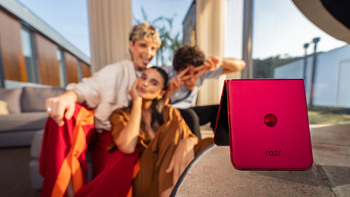What kind of customization should we expect from the Moto X?
This article may contain personal views and opinion from the author.

Today brought some interesting information regarding the Motorola Moto X. A leaked ad that came out not too long ago has revealed that the device will be customizable. There are still a lot of unanswered questions regarding the device, but we wanted to gather up what we know about the device and try to figure out what to expect from the customization options of the Moto X.
First, let's run through what we know for sure about the Moto X: we know that it will be widely available on multiple carriers. We know this because we have seen the FCC filings for the "X FON" on Verizon, AT&T, Sprint, and US Cellular. We know that the camera is most likely a 10.5MP shooter with a 16:9 aspect ratio based on the leaked images from the device. That's basically all we know for sure.
The list of things we have good reason to believe is a bit longer. Based on repeated comments by Google and Motorola executives, it's highly likely that the Moto X will feature more crack resistant glass (possibly sapphire glass), and a pretty hefty battery. Also based on the comments of Motorola CEO Dennis Woodside, it's fairly likely that the Moto X will offer lower price points than the competition, possibly by forgoing profit margins, like the Nexus line has done. All of the leaks for benchmarks and FCC filings that mention the processor of the device point towards it having a Snapdragon S4 Pro. Many of the leaks also point towards a 720p display. Our source close to the matter has confirmed the larger battery, the S4 Pro, the 720p display, and the fact that there will be more than 20 colors to choose from.
And, that brings us to the big question surrounding the Moto X:
What customization options will there be?
We know that there will be a choice of colors, that's a given. Many devices already offer different storage sizes, so we'll call that as a given as well. After those two things, we get into the realm of speculation and educated guessing. We're also keeping in mind that our source told us that engineers close to the project didn't know about any hardware customization plans as of March. If the engineers didn't know as of March, certain options get much harder to believe. So, we'll start with the most plausible customization options and work towards the options that are hardest to imagine.
1) Software customization - in the original rumor, it was said that customers would be able to choose the wallpaper, ringtones, apps, and contacts included on the device before you receive it. At the very least, the apps and contacts part of it would be easy enough to do, because Google has already been preloading devices with your saved content when you order a device from the Play Store. You purchase with your Play Store login, and the contacts, and apps you have backed up for your account will be preloaded. It's simple, a definite possibility, and would go a long way towards making the device "as unique as you are".
2) Choice of RAM - this one makes sense, because it would be relatively easy to do, and in conjunction with storage choices, it would create easy to understand pricing tiers for consumers. For example, a model with 16GB of storage and 1GB of RAM could be $299 (unlocked), while a model with 32GB of storage and 2GB of RAM could be $399.
3) Choice of display - the same reasoning goes for the choice of display as for the choice of RAM. Maybe you're fine with a 720p display, or maybe you're fine with paying a bit extra for a 1080p display.
4) Choice of processor - this one would be along the same lines as the choice of RAM or display, but would go more towards real power users. Would you be willing to pony up some extra cash to bump the device from a Snapdragon S4 Pro to a Snapdragon 800? Many of you would be, but it's a matter of whether it would cause too much trouble with the assembly process to make it a viable option.
5) Choice of wireless options - this one wouldn't necessarily be difficult to do, but there is very little reason to do it. LTE networks are going to be almost everywhere soon enough, and most people don't understand the various WiFi standards well enough to know if they want 802.11n or 802.11ac. There's a level of choice that's good, but this would just serve to confuse most consumers, complicate the buying process, and unnecessarily add to the build times for each device.
6) Choice of case material - this is another one that speaks to the difficulty in offering customization without burdening the assembly process or causing undue stress on the consumer. The choice of color is easy enough, just swap out the back plate, and you're good to go. However, adding in the choice of material starts causing more problems. Offering the choice of metal rather than plastic changes the entire assembly process, so that would seem like something the engineers would have known about a few months ago. Beyond that, it doesn't make much sense. Why would anyone choose plastic over a more rubberized back or even Kevlar?
The majority of users put cases on their devices anyway, so giving too much choice when it comes to the build materials seems pointless. Motorola can try to convince users that they don't need a case if there is hardened glass, etc., but customer paranoia might be too strong on that. Sure, there will be a few hardcore users who would want that choice (and no doubt, they are disproportionately represented in our readership), but it seems far more likely that Motorola would offer a choice of color and maybe a custom printed design on the back, but that's about it.
Conclusion
Ultimately, we would expect the majority of the customization of the device to come on the software side, because that's the kind of customization that Android is known for, and it's the kind of customization that the majority of users think of first. We all have to keep in mind that we here at PhoneArena are not the average consumer. We are all power users with more knowledge, and more finely tuned preferences as to what we want from our devices. We are not the target audience for Motorola. Motorola needs to get broad user support, which means offering customization options that make sense, don't complicate things, and don't lead to a notice that "your device will ship in 2-3 weeks".
That means simple customizations: the choice of color, choice of wallpaper, ringtones, and pre-installed apps. It means easily broken down price tiers, which would relate to storage capacity, RAM amount, and maybe display resolution. Beyond that the choices get too obscure, and the process to build the phone gets more complicated, so it seems far less likely.










Things that are NOT allowed: